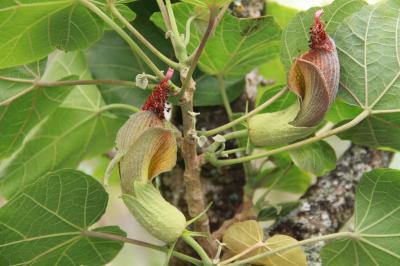Hibiscus flowers are an iconic symbol of tropical resorts worldwide but some are rather rare. Hawaii's State Flower, Hibiscus brackenridgei, is an endangered species.
Everyone knows of the Hawaiian hibiscus but few are aware of an equally beautiful and intriguing related group of plants known as Hibiscadelphus- literally "brother of Hibiscus".
Brother of Hibiscus is highly endangered. Until recently only one of the seven previously known species remained in its natural habitat, the other having gone extinct. These trees are only known, or were known, from five of the eight main Hawaiian Islands. Two are still alive in cultivation, saved in part because of their beautiful showy blossoms. Several were only known from a single wild tree.
In 2012, botanists Hank Oppenheimer&Keahi Bustament with the Plant Extinction Prevention Program, and Steve Perlman of the National Tropical Botanical Garden found a population of these unique trees in a remote, steep valley on the west side of Maui, near the resorts areas of Lahaina and Ka`anapali.

The flowers or hau kuahiwi are filled with nutrient rich nectar, and are an important food source for Hawaiian honeyeater birds, now also mostly extinct. Credit: Hank Oppenheimer, Plant Extinction Prevention Program
Until then the trees have never been known from this area. After careful study at the Bernice Pauahi Bishop Museum in Honolulu and elsewhere, comparing the new trees with all those previously known, it was concluded that these represented a species new to science. Even more astounding was the number of trees found- 99- which is likely more than all the other species ever known combined.
Hawaiians know these trees as hau kuahiwi- hau being a type of lowland Hibiscus common throughout the tropical Pacific, and kuahiwi referring to its upland or mountain habitat. They recognized their similarities while keenly observing their differences.
"Every new species discovered is exciting but this species, belonging to such a unique endemic island lineage, is more special than that" said Dr. Art Medeiros, biologist with the U.S. Geological Survey on Maui. "Besides being beautiful, it is a true contribution to Hawaiian natural history."





Comments